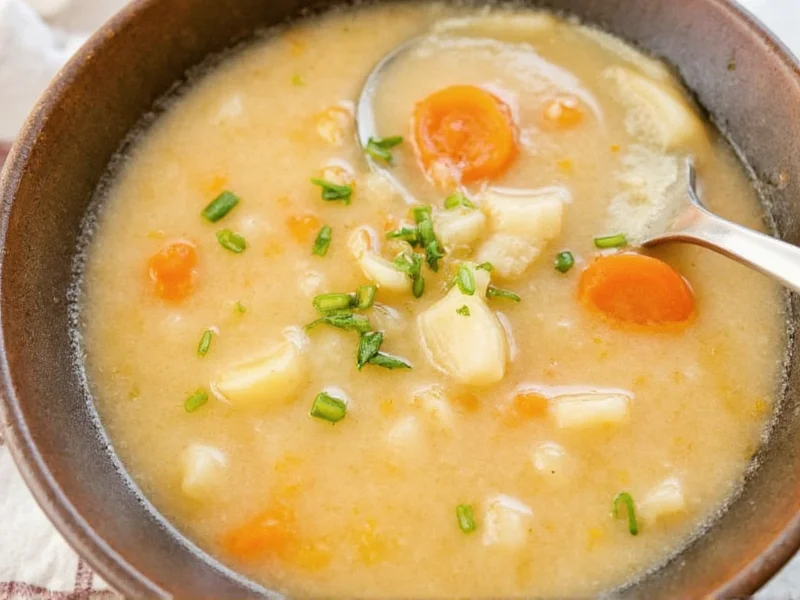Crockpot onion soup represents the perfect marriage of traditional French culinary technique and modern convenience. By leveraging the slow, steady heat of a countertop cooker, home chefs can achieve restaurant-quality results without constant monitoring. The extended cooking time allows onions to naturally caramelize through enzymatic browning rather than high-heat searing, developing nuanced sweet-savory flavors while preserving their nutritional benefits.
Why Crockpot Method Elevates Classic Onion Soup
Traditional French onion soup requires nearly constant attention as onions slowly caramelize over low heat—a process that can take 45-60 minutes of stirring and scraping. The crockpot method eliminates this labor-intensive step while enhancing flavor development through controlled, gradual cooking. Temperature consistency in slow cookers prevents the common pitfall of burnt onions that can happen with stovetop preparation.
Food science explains why this works: onions contain natural sugars that undergo the Maillard reaction between 140-165°C (284-329°F). Crockpots maintain temperatures around 85-95°C (185-203°F), allowing slower, more complete caramelization without scorching. This extended process breaks down complex carbohydrates into simpler sugars, creating richer flavor compounds than high-heat methods.
Essential Ingredients and Their Roles
The magic of exceptional crockpot onion soup lies in ingredient selection and proportions. While traditional recipes serve four, this slow cooker adaptation scales perfectly for both intimate dinners and meal prep.
| Ingredient | Quantity | Function |
|---|---|---|
| Yellow onions | 6 large (about 3 lbs) | Primary flavor base with balanced sweetness and pungency |
| Butter | 3 tablespoons | Enhances caramelization and carries fat-soluble flavor compounds |
| Dry white wine | 1 cup | Acid component that deglazes and adds complexity |
| Beef broth | 4 cups low-sodium | Provides umami depth without overpowering onion flavor |
| Thyme | 2 sprigs fresh | Earthy herbal note that complements slow-cooked onions |
Step-by-Step Preparation Guide
Follow this optimized method for foolproof crockpot onion soup that develops maximum flavor with minimal effort:
- Prep onions: Slice 6 large yellow onions pole-to-pole (not across the equator) into 1/8-inch slices. This preserves more cell structure for better texture.
- Layer strategically: Melt butter in crockpot on high setting, then add onions, salt, and sugar. Stir to coat, but avoid packing them down.
- Initial high-heat phase: Cook uncovered on high for 2 hours, stirring once after first hour. This jumpstarts caramelization.
- Slow transformation: Reduce to low setting, cover, and cook 6-8 hours. The extended time develops deep flavor without burning.
- Wine integration: After 4 hours, add 1 cup dry white wine and 2 thyme sprigs. The alcohol helps extract additional flavor compounds.
- Broth addition: During last 2 hours, add 4 cups low-sodium beef broth. Avoid adding too early, which would prevent proper caramelization.
- Final seasoning: Remove thyme stems, then adjust salt, pepper, and a splash of sherry vinegar to brighten flavors.
Avoiding Common Crockpot Onion Soup Mistakes
Even experienced cooks encounter pitfalls with slow cooker onion soup. Understanding these issues prevents disappointing results:
- Overcrowding the pot: Too many onions prevent proper evaporation and lead to steamed rather than caramelized onions. Maintain single-layer capacity.
- Adding liquid too early: Broth introduced before sufficient caramelization dilutes flavors and prevents proper Maillard reaction.
- Incorrect onion variety: Red onions contain more water and less sugar, while sweet onions like Vidalia can become overly sweet without balancing pungency.
- Skipping the wine step: The acidity and alcohol in wine help extract additional flavor compounds that water alone cannot.
Flavor Variations and Customizations
Once you've mastered the basic crockpot onion soup technique, these variations offer exciting twists:
- Vegetarian version: Substitute mushroom broth for beef broth and add 2 tablespoons soy sauce for umami depth
- Smoky depth: Add 1 teaspoon liquid smoke during last hour of cooking
- Spiced variation: Include 1 star anise and 3 black peppercorns during cooking, removing before serving
- Cheese crust alternative: For gluten-free option, top with aged gouda instead of traditional baguette
Serving and Storage Recommendations
Proper presentation elevates crockpot onion soup from simple comfort food to restaurant-worthy dish:
- Brown ceramic bowls enhance the visual appeal of the golden broth
- Toast baguette slices separately before adding to prevent sogginess
- Apply cheese topping during final broiling step for optimal melt and browning
- Store cooled soup in airtight containers for up to 4 days or freeze portions for 3 months
- Reheat gently on stove—avoid boiling which can separate the broth
Troubleshooting Guide
Address these common issues with targeted solutions:
- Too sweet: Balance with additional salt and 1-2 teaspoons apple cider vinegar
- Too salty: Add raw potato chunks during reheating to absorb excess salt
- Watery consistency: Simmer uncovered for 20-30 minutes to reduce
- Lacking depth: Stir in 1 teaspoon Worcestershire sauce and simmer 15 minutes











 浙公网安备
33010002000092号
浙公网安备
33010002000092号 浙B2-20120091-4
浙B2-20120091-4